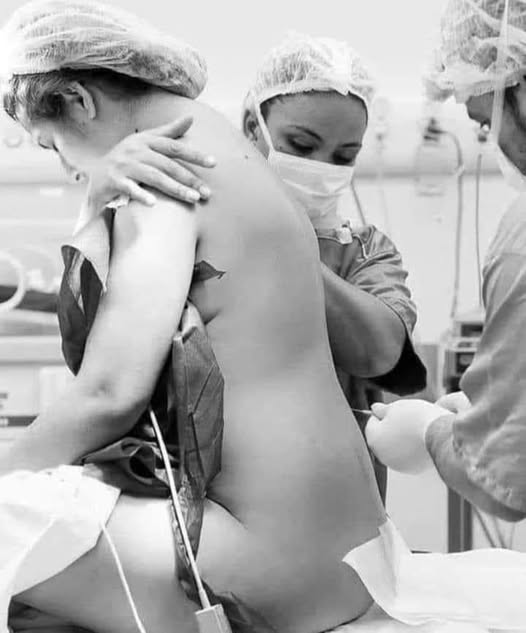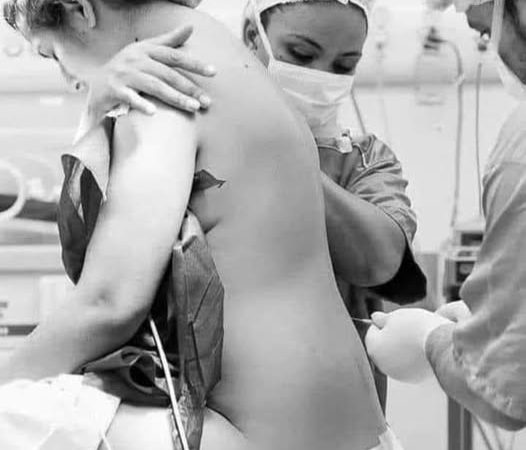This Photo Captures a Moment Before Everything Changes
This powerful image shows a woman sitting still as a medical team prepares her for a spinal injection. At a glance, it looks clinical—routine. But what it really captures is the first step in an unimaginable sacrifice. It’s the quiet before the storm. This is the moment before a woman becomes a warrior.
That injection marks the start of a caesarean section—a procedure often dismissed as “just a surgery,” but in reality, it is a profound act of endurance, bravery, and unconditional love.

C-Section: Not Just a Surgery—A Transformation
Too often, society diminishes C-sections with lines like:
“Oh, you didn’t really give birth—you had a caesarean.”
Or, “At least you didn’t have to go through labor.”
Let’s be clear. A C-section is major abdominal surgery, performed not for comfort, but often out of urgent necessity—to save a mother, a baby, or both. And it comes with its own set of agonizing challenges.
The scalpel cuts through eight layers of flesh, fat, tissue, and muscle. Even the uterus is opened. Organs are moved aside to reach the baby. Blood loss is common. Sometimes, the mother hears her baby cry while she herself is unable to move or speak due to the anesthesia and numbness.
It’s not just physical—it’s emotional trauma, too. Many mothers feel torn between joy and fear, pain and pride.
Video : Spinal Block For C-Section
That Needle in the Spine? It Changes Everything
That thick needle delivering spinal anesthesia? It’s more than just a shot—it’s the silent start of a lifelong story. It causes many women to deal with permanent back pain, nerve sensitivity, or numbness. Some never fully recover from it.
She sits hunched over, vulnerable and half-naked in a freezing operating room, trusting complete strangers to open her body, trusting them with her life and the life of her child.
The Next 24 Hours: Pain No Words Can Describe
As the anesthesia wears off, a storm of pain begins. The mother is left with a deep wound across her abdomen—raw, burning, and vulnerable. For the first 24 hours, she can’t stand. She can’t even roll over in bed without help. Every small movement—coughing, laughing, even breathing—feels like someone is ripping her from the inside.
Still, she must breastfeed her newborn, endure visitors, and listen to advice from relatives who weren’t there when she was being stitched up on the table.

And Then the Real Work Begins
In the days and weeks after surgery, the wound still bleeds. The stitches pull. Her uterus contracts painfully. Her belly remains swollen. She’s often asked, “When will you bounce back?” as if this body didn’t just perform a miracle.
She can’t lift her baby without pain. She can’t bend over to put on her shoes. She walks hunched over, slowly, like a shadow of herself. And yet, she gets up for every cry, every diaper change, every midnight feed.
With every movement, the scar reminds her of what she went through—and what she gained.
Saline, Catheters, and Silent Strength
After surgery, her arms are punctured with IVs. The saline burns into sore veins. The catheter freezes her body with discomfort. Her skin stings. Her muscles throb. But no one tells you how bad it will feel to sit upright for the first time—or how you’ll cry when they ask you to walk just a few feet to the bathroom.
And while you wobble toward the restroom, you’re still expected to cradle a newborn in your arms with a smile.
Video : How A C-Section Is Performed 🤔
She’s Expected to Heal and Host
Even in pain, the mother must receive guests. People coo at the baby while barely glancing at her. Her body is aching, stitched, leaking, and swollen, but she is expected to smile and say thank you. No one sees the trembling beneath the surface. No one notices the tears she holds back when breastfeeding hurts or when the pain medication wears off too soon.
And let’s not forget—many C-section moms are already dealing with postpartum depression, hormonal swings, and self-doubt.
And Yet She’s Told: “It Was Just a C-Section”
This statement might be the cruelest of all. It erases every ounce of her courage and sacrifice. It ignores the lifelong pain, the physical limits she faces, the scar she touches every day when she changes clothes. Some days she can’t lift heavy groceries. Some days she can’t walk too far. Her back aches. Her scar pulls. But she never complains.
Because she is a mother.
Respect Every Birth. Honor Every Mother.
Whether a woman delivers vaginally or through surgery, her experience is valid. Her pain is real. Her strength is immeasurable.

No one has the right to compare, judge, or diminish her story. Because whether she pushed for hours or lay still on a cold table, she brought life into this world. And that deserves nothing less than absolute respect.
Conclusion: The Quiet Strength of a C-Section Mother
A C-section is not an easy way out. It’s not a shortcut. It’s a battlefield—and the mother is both the soldier and the survivor. She carries the weight of that day in her body and in her heart forever.
So the next time you see a mother with a scar on her belly and a baby in her arms, don’t ask how she gave birth. Don’t compare. Just honor her.
Because that scar? That’s not weakness. That’s proof of her strength.



